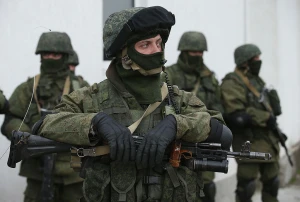
Asymmetric warfare model and reserve stock of weapons: how Taiwan could defend itself against China
Taipei could prepare before any conflict begins, taking into account Ukraine's experience, CNN’s Eric Cheung says in his analysis
When Taiwanese President Tsai Ing-wen dismissed Chinese warnings earlier this month to meet with US House Speaker Kevin McCarthy in California, Beijing's powerful military response resonated throughout the world, CNN reports.
During a three-day military exercise, China's army simulated a blockade of the island by sending an aircraft carrier and 12 naval ships to encircle it and flying over a hundred warplanes into its air defense identification zone.
The drills were described as "joint precision strikes" by China's ruling Communist Party, which claims Taiwan as part of its territory despite never having held it. They should serve as a "serious warning against Taiwan separatist forces."
The message, in Taipei’s mind, seemed clear. China appeared “to be trying to get ready to launch a war against Taiwan,” the island’s Foreign Minister Joseph Wu told CNN’s Jim Sciutto.
In March, Defense Minister Chiu Kuo-cheng told Taiwan's parliament that Taipei was in talks with the US on establishing a war reserve stock on the island.
While Taiwan has long been a buyer of US weapons, military experts say such a stockpile could be critical to the island's defense because, as China's recently simulated blockade demonstrated, it could be extremely difficult to supply the island with additional weapons if war breaks out.
Taiwan, unlike Ukraine, has no land borders, so any supplies would have to be delivered by air or sea, both of which are very vulnerable to interceptions by the Chinese military.
Taiwan has also repeatedly raised concerns about delays in US weapon deliveries amid the war in Ukraine. Following his meeting with Tsai, Speaker McCarthy tweeted: “Based on today’s conversations, it’s clear several actions are necessary: We must continue arms sales to Taiwan and make sure such sales reach Taiwan on time.”
Asymmetric warfare model
For decades, Taiwan's military has purchased fighter jets and missiles from the United States, which remains the island's single most important guarantor of safety despite an absence of a "official" diplomatic relationship.
The Biden administration made news last month when it approved potential military shipments to Taiwan for $619 million, including hundreds of missiles for its fleet of F-16 fighter jets.
But Admiral Lee said Taiwan urgently needed to stock up on smaller and more mobile weapons that would have a higher chance of surviving the first wave of a Chinese attack in an all-out conflict.
Lee argued, Taiwan should embrace an asymmetric warfare model focused on the procurement of smaller weapons – such as portable missiles and mines – that are hard to detect but effective in halting enemy advances.
“In Ukraine, their military has used Neptune anti-ship missiles to sink Moscow’s battleships,” he said. “Asymmetric weapon systems will allow us to maintain our combat capabilities. That is because if our enemies want to destroy them, they will need to get closer to us, which makes them vulnerable to our attack.”
“If we can establish good enough asymmetrical capability, I believe China won’t be able to take over Taiwan by force, even without United States’ intervention,” he added.
Portable weapons
Taiwan will be eligible for up to $1 billion in weapons and ammunition from the United States under this year's National Defense Authorization Act, which was enacted by the US Congress and signed by US President Joe Biden.
The act also permits for the establishment of a regional contingency stockpile, allowing the Pentagon to store weapons in Taiwan for use in the event of a military war with China.
The US Indo-Pacific Command declined to comment on the status of talks to build the stockpile, but stated that it would continue to allow Taiwan to maintain a sufficient self-defense capability.
Another weapon that may be stored, according to Admiral Lee, is the Javelin, a portable anti-tank weapon system produced in the United States that has been regularly employed by the Ukrainian military to fight Russian tanks.
He believes the National Advanced Surface-to-Air Missile System, or NASAMS, could be helpful in targeting Chinese jets since it can fire the medium-range AIM-120 missile from ground level.
How many is enough?
Experts claimed it was difficult to provide a specific number because the potential fighting scenarios were so diverse.
In order to gain control over Taiwan, the Chinese military may pursue a variety of strategies.
In the event of a full-fledged war, China may use long-range missiles to strike Taiwanese infrastructure and military targets before sending ground troops over the Taiwan Strait.
Other scenarios involving limited military action could include an aerial and naval blockade of Taiwan or the capture of Taiwan's small outlying islands along the Chinese coast.
Lin Ying-yu, an assistant professor from Tamkang University who specializes in military affairs, suggested the number of missiles that Taiwan likely needs would be in the “tens of thousands.”
Lin noted that, in addition to weapons, Taiwan's military may benefit from mobile radar equipment that would allow it to receive military signals from the US.
“Even though the United States does not have troops on the ground in Ukraine, it has been able to tell the Ukrainian military where to fire their weapons by sending signals from its electronic warfare aircraft,” Lin said. “We need to make sure we have the necessary equipment to link with US military systems at times of war.”
There were other reasons why negotiations with the US about a hypothetical stockpile were crucial, according to Admiral Lee, and these went beyond the question of stockpiling ammunition and spare components.
“(Having a contingency stockpile) is very crucial, because it sends a signal to China that the United States is determined to assist in our defense,” he said.
- News













































